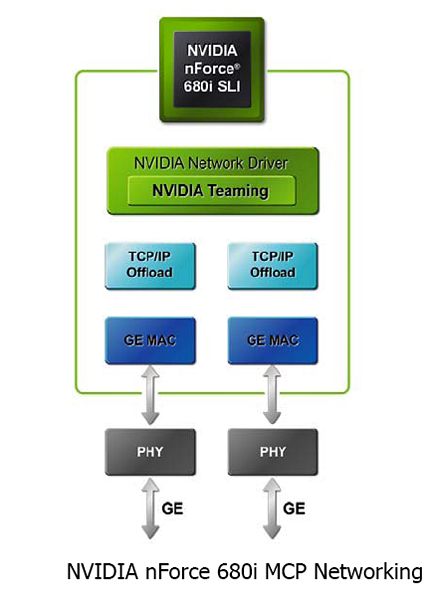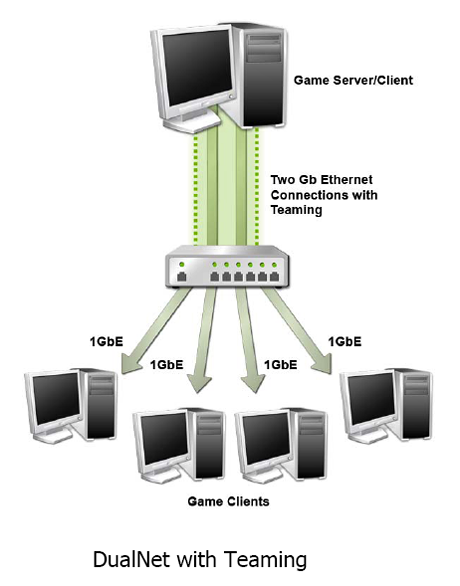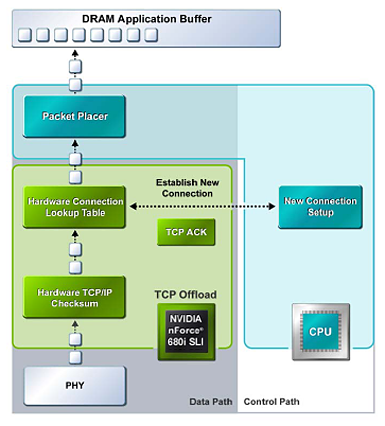NVIDIA 680i: The Best Core 2 Chipset?
by Gary Key & Wesley Fink on November 8, 2006 4:45 AM EST- Posted in
- CPUs
DualNet
DualNet's suite of options actually brings a few enterprise type network technologies to the general desktop such as teaming, load balancing, and fail-over along with hardware based TCP/IP acceleration. Teaming will double the network link by combining the two integrated Gigabit Ethernet ports into a single 2-Gigabit Ethernet connection. This brings the user improved link speeds while providing fail-over redundancy. TCP/IP acceleration reduces CPU utilization rates by offloading CPU-intensive packet processing tasks to hardware using a dedicated processor for accelerating traffic processing combined with optimized driver support.
While all of this sounds impressive, the actual impact for the general computer user is minimal. On the other hand, a user setting up a game server/client for a LAN party or implementing a home gateway machine will find these options very valuable. Overall, features like DualNet are better suited for the server and workstation market. We believe these options are being provided (we are not complaining) since the NVIDIA professional workstation/server chipsets are based upon the same core logic.

NVIDIA now integrates dual Gigabit Ethernet MACs using the same physical chip. This allows the two Gigabit Ethernet ports to be used individually or combined depending on the needs of the user. The previous NF4 boards offered the single Gigabit Ethernet MAC interface with motherboard suppliers having the option to add an additional Gigabit port via an external controller chip. This too often resulted in two different driver sets, with various controller chips residing on either the PCI Express or PCI bus and typically worse performance than a well-implemented dual-PCIe Gigabit Ethernet solution. .
Teaming

Teaming allows both of the Gigabit Ethernet ports in NVIDIA DualNet configurations to be used in parallel to set up a 2-Gigabit Ethernet backbone. Multiple computers can to be connected simultaneously at full gigabit speeds while load balancing the resulting traffic. When Teaming is enabled, the gigabit links within the team maintain their own dedicated MAC address while the combined team shares a single IP address.
Transmit load balancing uses the destination (client) IP address to assign outbound traffic to a particular gigabit connection within a team. When data transmission is required, the network driver uses this assignment to determine which gigabit connection will act as the transmission medium. This ensures that all connections are balanced across all the gigabit links in the team. If at any point one of the links is not being utilized, the algorithm dynamically adjusts the connection to ensure an optimal connection. Receive load balancing uses a connection steering method to distribute inbound traffic between the two gigabit links in the team. When the gigabit ports are connected to different servers, the inbound traffic is distributed between the links in the team.

The integrated fail-over technology ensures that if one link goes down, traffic is instantly and automatically redirected to the remaining link. If a file is being downloaded as an example, the download will continue without loss of packet or corruption of data. Once the lost link has been restored, the grouping is re-established and traffic begins to transmit on the restored link.
NVIDIA quotes on average a 40% performance improvement in throughput can be realized when using teaming although this number can go higher. In their multi-client demonstration, NVIDIA was able to achieve a 70% improvement in throughput utilizing six client machines. In our own internal test we realized about a 36% improvement in throughput utilizing our video streaming benchmark while playing Serious Sam II across three client machines. For those without a Gigabit network, DualNet has the capability to team two 10/100 Fast Ethernet connections. Once again, this is a feature set that few desktop users will truly be able to exploit at the current time. However, we commend NVIDIA for forward thinking in this area as we see this type of technology being useful in the near future.
TCP/IP Acceleration
NVIDIA TCP/IP Acceleration is a networking solution that includes both a dedicated processor for accelerating networking traffic processing and optimized drivers. The current nForce 590SLI and nForce 680i SLI MCP chipsets have TCP/IP acceleration and hardware offload capability built in to both native Gigabit Ethernet Controllers. This capability will typically lower the CPU utilization rate when processing network data at gigabit speeds.

In software solutions, the CPU is responsible for processing all aspects of the TCP protocol: Checksumming, ACK processing, and connection lookup. Depending upon network traffic and the types of data packets being transmitted this can place a significant load upon the CPU. In the above example all packet data is processed and then checksummed inside the MCP instead of being moved to the CPU for software-based processing that improves overall throughout and CPU utilization.
NVIDIA dropped the ActiveArmor slogan for the nForce 500 release and it is no different for the nForce 600i series. Thankfully the ActiveArmor firewall application was jettisoned to deep space as NVIDIA pointed out that the basic features provided by ActiveArmor will be a part of Microsoft Vista. We also feel NVIDIA was influenced to drop ActiveArmor due to the reported data corruption issues with the nForce4 caused in part by overly aggressive CPU utilization settings, customer support headaches, issues with Microsoft, and quite possibly hardware "flaws" in the original nForce MCP design.
We have found a higher degree of stability with the new TCP/IP acceleration design but this stability comes at a price. If TCP/IP acceleration is enabled via the control panel, then certain network traffic will bypass third party firewall applications. We noticed CPU utilization rates near 14% with the TCP/IP offload engine enabled and rates near 26% without it.
DualNet's suite of options actually brings a few enterprise type network technologies to the general desktop such as teaming, load balancing, and fail-over along with hardware based TCP/IP acceleration. Teaming will double the network link by combining the two integrated Gigabit Ethernet ports into a single 2-Gigabit Ethernet connection. This brings the user improved link speeds while providing fail-over redundancy. TCP/IP acceleration reduces CPU utilization rates by offloading CPU-intensive packet processing tasks to hardware using a dedicated processor for accelerating traffic processing combined with optimized driver support.
While all of this sounds impressive, the actual impact for the general computer user is minimal. On the other hand, a user setting up a game server/client for a LAN party or implementing a home gateway machine will find these options very valuable. Overall, features like DualNet are better suited for the server and workstation market. We believe these options are being provided (we are not complaining) since the NVIDIA professional workstation/server chipsets are based upon the same core logic.

NVIDIA now integrates dual Gigabit Ethernet MACs using the same physical chip. This allows the two Gigabit Ethernet ports to be used individually or combined depending on the needs of the user. The previous NF4 boards offered the single Gigabit Ethernet MAC interface with motherboard suppliers having the option to add an additional Gigabit port via an external controller chip. This too often resulted in two different driver sets, with various controller chips residing on either the PCI Express or PCI bus and typically worse performance than a well-implemented dual-PCIe Gigabit Ethernet solution. .
Teaming

Teaming allows both of the Gigabit Ethernet ports in NVIDIA DualNet configurations to be used in parallel to set up a 2-Gigabit Ethernet backbone. Multiple computers can to be connected simultaneously at full gigabit speeds while load balancing the resulting traffic. When Teaming is enabled, the gigabit links within the team maintain their own dedicated MAC address while the combined team shares a single IP address.
Transmit load balancing uses the destination (client) IP address to assign outbound traffic to a particular gigabit connection within a team. When data transmission is required, the network driver uses this assignment to determine which gigabit connection will act as the transmission medium. This ensures that all connections are balanced across all the gigabit links in the team. If at any point one of the links is not being utilized, the algorithm dynamically adjusts the connection to ensure an optimal connection. Receive load balancing uses a connection steering method to distribute inbound traffic between the two gigabit links in the team. When the gigabit ports are connected to different servers, the inbound traffic is distributed between the links in the team.

The integrated fail-over technology ensures that if one link goes down, traffic is instantly and automatically redirected to the remaining link. If a file is being downloaded as an example, the download will continue without loss of packet or corruption of data. Once the lost link has been restored, the grouping is re-established and traffic begins to transmit on the restored link.
NVIDIA quotes on average a 40% performance improvement in throughput can be realized when using teaming although this number can go higher. In their multi-client demonstration, NVIDIA was able to achieve a 70% improvement in throughput utilizing six client machines. In our own internal test we realized about a 36% improvement in throughput utilizing our video streaming benchmark while playing Serious Sam II across three client machines. For those without a Gigabit network, DualNet has the capability to team two 10/100 Fast Ethernet connections. Once again, this is a feature set that few desktop users will truly be able to exploit at the current time. However, we commend NVIDIA for forward thinking in this area as we see this type of technology being useful in the near future.
TCP/IP Acceleration
NVIDIA TCP/IP Acceleration is a networking solution that includes both a dedicated processor for accelerating networking traffic processing and optimized drivers. The current nForce 590SLI and nForce 680i SLI MCP chipsets have TCP/IP acceleration and hardware offload capability built in to both native Gigabit Ethernet Controllers. This capability will typically lower the CPU utilization rate when processing network data at gigabit speeds.

In software solutions, the CPU is responsible for processing all aspects of the TCP protocol: Checksumming, ACK processing, and connection lookup. Depending upon network traffic and the types of data packets being transmitted this can place a significant load upon the CPU. In the above example all packet data is processed and then checksummed inside the MCP instead of being moved to the CPU for software-based processing that improves overall throughout and CPU utilization.
NVIDIA dropped the ActiveArmor slogan for the nForce 500 release and it is no different for the nForce 600i series. Thankfully the ActiveArmor firewall application was jettisoned to deep space as NVIDIA pointed out that the basic features provided by ActiveArmor will be a part of Microsoft Vista. We also feel NVIDIA was influenced to drop ActiveArmor due to the reported data corruption issues with the nForce4 caused in part by overly aggressive CPU utilization settings, customer support headaches, issues with Microsoft, and quite possibly hardware "flaws" in the original nForce MCP design.
We have found a higher degree of stability with the new TCP/IP acceleration design but this stability comes at a price. If TCP/IP acceleration is enabled via the control panel, then certain network traffic will bypass third party firewall applications. We noticed CPU utilization rates near 14% with the TCP/IP offload engine enabled and rates near 26% without it.










60 Comments
View All Comments
StriderGT - Thursday, November 9, 2006 - link
Also, some Intel chipset fans believe that Intel chipsets are best for a rock solid system (for the record, I'm not one of these people), I guess we'll see if nVidia will change thier minds.No it won't, its the same group of people that suggested the P4 was a more "stable" platform than the Athlon 64 platform. Its simply a psychological state of denial, when someone has paid more for less needs an excuse: "Stability"
skrewler2 - Wednesday, November 8, 2006 - link
I agree with you on your two points.I also wish PM tech was standardized.. I just went through a headache researching what was compatible with what chipset etc, imo it should just all work. From what I understand, the SATA II standard isn't even really a standard at all.. anyways I agree that NV should start implementing Port Multiplier support!
yyrkoon - Wednesday, November 8, 2006 - link
Yeah, I recently bought a budget Asrock board that SUPPOSEDLY supported SATAII connections. As per the standard, SATAII is supposed to support native command queuing (NCQ), and up to 3Gbit/s throughput on each connector. Anyhow this motherboard does not support NCQ . . . which is the majority of the reason to own a SATAII drive / interface, the rest is basicly marketing hype.Kougar - Wednesday, November 8, 2006 - link
Wanted to point out all the tables on the Memory Performance page are mislabled as "980i".Also some power consumption figures would be good, even if not critical. With a chipset cooler that huge it's about a giveaway it is hiding a nice and crispy chipset! ;) Thanks for the article!
Wesley Fink - Wednesday, November 8, 2006 - link
The perils of Table cut-and-paste are now corrected.Please see comments above above Power Consumption. That information will be added to the review since several have requested it.
Avalon - Wednesday, November 8, 2006 - link
I was much more interested in the 650i Ultra boards, specifically how well they overclocked compared to the 680i you benched. Additionally, do you think it's necessary for an active fan cooling the northbridge when highly overclocked on this chipset, or does it run fairly cool?Gary Key - Wednesday, November 8, 2006 - link
We will not have 650i boards until early December for review. The fan is required for upper-end 24/7 overclocking in my opinion, otherwise the board ran fine without it.yzkbug - Wednesday, November 8, 2006 - link
tables in page 10: NVIDIA 980i -> NVIDIA 680iShoNuff - Wednesday, November 8, 2006 - link
I'm impressed with the review. It was very thorough. In particular, I was amazed at your overclock with the X6800. I am looking forward to getting one of these boards in my hands.
It appears that NVIDIA has done it this time with respect to the on board memory controller. It is hard to imagine things getting better when the OEM's add their nuances to this board. If results are this good based upon the reference design, it is almost scary thinking about how good a board DFI would/could produce.
Oh…and btw…I like the new location of the front panel connectors. The new location will make it easier to "stealth" the wires.
hubajube - Wednesday, November 8, 2006 - link
These are ass-kicking OC's!!! Can't wait to own this board.